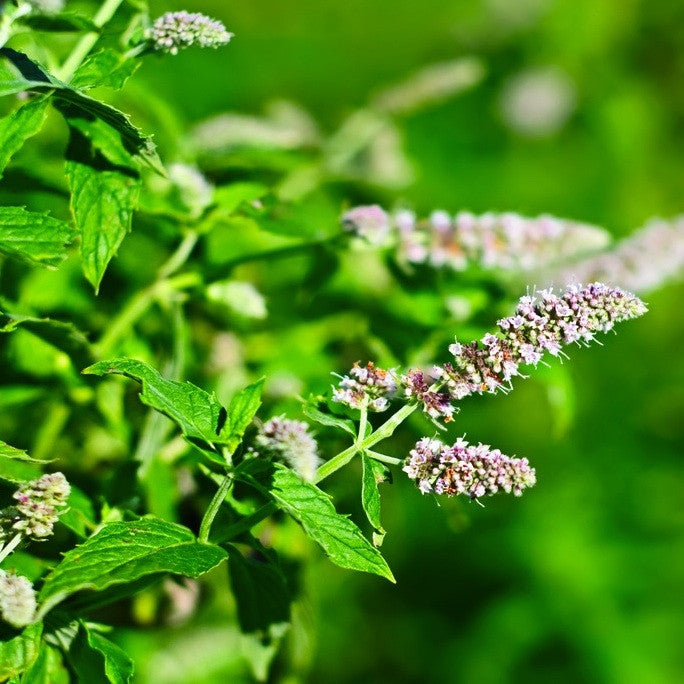TIMELESS Essential Oils
Spearmint, Premium
Couldn't load pickup availability
Product Details
SALE : 40% Off
Botanical name : Mentha spicata or Mentha viridis
Extraction method / Source : Steam Distilled / Fresh flowering tops
Aroma : Sweet, fresh, herbaceous
Note classification : Top, Middle
Odor Intensity : 5
Key constituents : Carvone, limonene, beta-pinene, linalool
Plant description : Botanical family: Laminaceae
Spearmint is a perennial plant native to the Mediterranean region. It grows to a height of about 1-3 feet and has highly fragrant shiny green leaves and white or lilac flowers.
Regions of Production : USA, India
Growing Practices : Cultivated without the use of chemical fertilizers or pesticides.
History / Fun Facts : Historically, spearmint has had many interesting uses. In medieval times it was used to help heal sore gums, whiten teeth and promote good oral hygeine. It has also been widely used as a local anesthetic, digestive aid and antiseptic. In Britain, spearmint was used to keep milk from curdling.
Properties
Properties : Antiseptic, antispasmodic, digestive aid, insecticide, promotes mental focus, restorative, stimulant, supports healthy menstruation.
Fragrant influences : Uplifting, helps reduce mental strain, fatigue and depression. Stimulates the mind and improves mental clarity.
Uses / Benefits : Pure Spearmint essential oil is cooling, refreshing, stimulating, and aids digestion. The vapors of Spearmint oil help open breathing passages and are helpful for managing asthma, bronchitis, and sinus conditions. Spearmint oil helps ease muscle pain, headaches and menstrual discomfort, and soothes itchy skin. Natural insect repellent. Used in natural perfume making.
Modes of Administration : Topical: massage, compress, bath, salves and balms
Inhalation: direct inhalation, diffuser, oil vaporizer
Blends well with : Allspice, Anise, Basil, Black Pepper, Cabreuva, Cajeput, Caraway, Cardamom, Cassia, Cedarwood, Clove, Coriander, Cumin, Cypress, Dill, Fennel, Ginger, Gingergrass, Hyssop, Lavender, Lemon, Lemongrass, Lime, Mandarin, Palmarosa, Patchouli, Peppermint, Rose, Rosemary, Vetiver
Safety
Safety : Non-toxic, non-irritating, non-sensitizing. (Battaglia, 2003)
Notice : This information is for educational purposes only. It has not been evaluated by the US Food and Drug Administration. It is not intended to diagnose, treat, cure or prevent any condition or disease. Although we strive to provide information which is accurate and up to date, we cannot guarantee the accuracy or completeness of this information.
Precautions : Pure essential oils are highly concentrated plant extracts. Do not use them undiluted, or in the eyes or mucus membranes. If applying an essential oil to the skin, always dilute it with a proper carrier oil and test on a small patch of skin before applying to a large area. Do not take them internally except under the direction of a qualified professional trained in Aromatherapy. Always familiarize yourself with the safety, contraindications and proper preparation of each essential oil before use. Note that when using essential oils for children and the elderly, very low concentrations should be used. Keep all essential oils away from children and pets.
References
Althea Press, Essential Oils: Natural Remedies, 2015. Althea Press, Berkeley, CA.
Battaglia, Salvatore, The Complete Guide to Aromatherapy, Second Edition, 2003. The International Centre of Holistic Aromatherapy, Brisbane, Australia
Cooksley, Valerie Gennari, Aromatherapy: Soothing Remedies to Restore, Rejuvenate, and Heal, 2002. Prentice Hall Press, New York, NY.
Cooksley, Valerie Gennari, Aromatherapy: A Holistic Guide to Natural Healing with Essential Oils, 2015. Floramed Publishing, The Woodlands, TX.
United States Food and Drug Administration, HHS, 182.1 Substances That Are Generally Recognized as Safe, 182.20 Essential oils, Oleoresins (solvent-free), and natural extractives (including distillates), http://www.gpo.gov/fdsys/CFR-2012-title21-vol3-sec182 (January 28, 2016)


